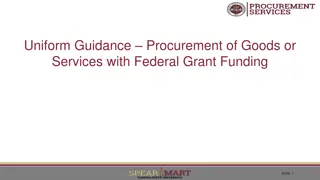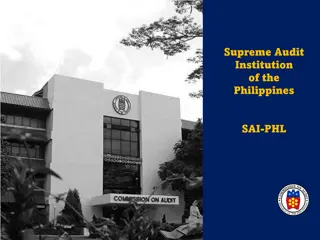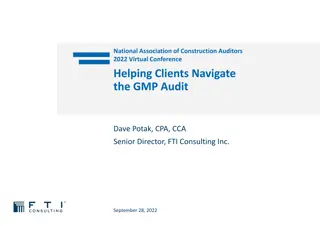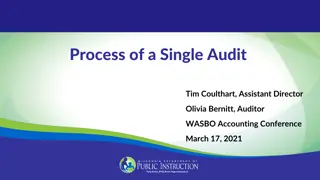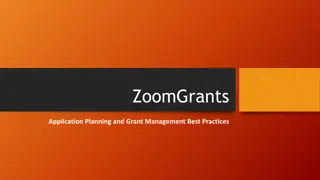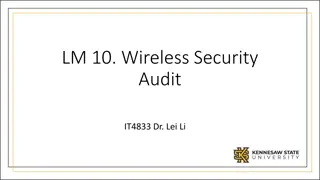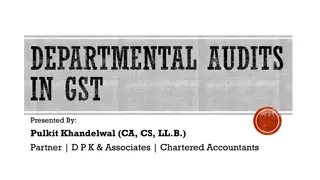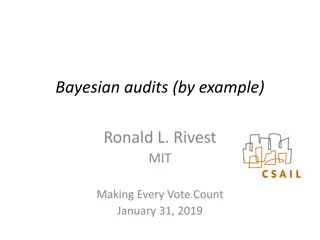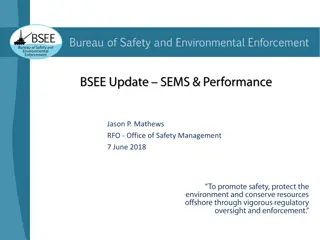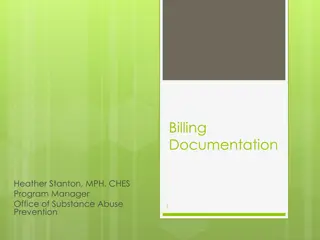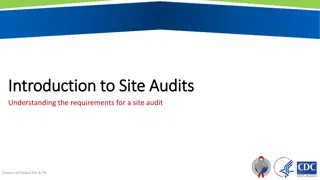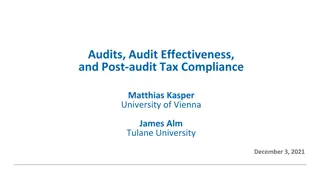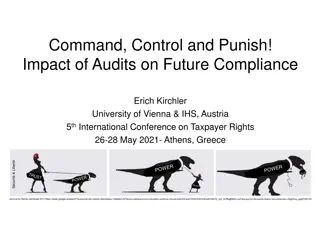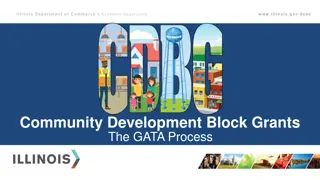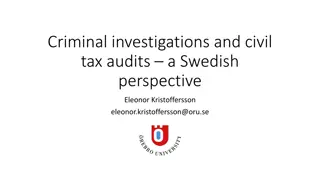Understanding Single Audits in Federal Grant Programs
Audits play a crucial role in ensuring accountability in Federal grant programs. Single Audits, being the most common type, combine financial and compliance audits into one report. Learn about threshold determinations, risk-based approaches, and key changes in the Uniform Guidance through this comprehensive guide. Stay informed on current requirements, issues, and resources for effective grant management.
Download Presentation

Please find below an Image/Link to download the presentation.
The content on the website is provided AS IS for your information and personal use only. It may not be sold, licensed, or shared on other websites without obtaining consent from the author. Download presentation by click this link. If you encounter any issues during the download, it is possible that the publisher has removed the file from their server.
E N D
Presentation Transcript
The Uniform Guidance Audit Requirements 2 CFR Part 200 Subpart F U.S. Department of Education
Learning Objectives By the end of this presentation, you should: Understand the role of audits in accountability Get an overview of how Single Audits are conducted, and what they include Learn the key changes in the Uniform Guidance relating to Single Audits, and their implications for ED and grantees Know the timeline for implementation of changes Be aware of available resources and training Updated June 25, 2015 2
Overview AUDITS and SINGLE AUDITS Current Requirements Issues relating to audits KEY CHANGES Overview Key Changes and their Impact Timeline RESOURCES 3
Audits and Accountability Audits are one of several tools available for assessing grantees performance and ensuring accountability. The information they yield is valuable because it is based on a systematic process of objectively obtaining and assessing evidence to determine if grantees actual programs or operations meet established criteria. The use of audit data is an important aspect of implementing the Department s goal of improving program efficacy through comprehensive risk management and grant monitoring Updated June 25, 2015 4
Single Audits: Current Requirements, Basic Structure Single Audits are the most widespread type of audits of Federal government programs. Entities that expend a minimum ( threshold ) level of Federal funds are subject to audit requirements that are commonly referred to as Single Audits. Single Audits: Are authorized under the Single Audit Act, as amended in 1996, and OMB guidance Use a risk-based approach to determine which Federal programs are covered Combine a financial audit and a compliance audit into one report Updated June 25, 2015 5
Single Audit Requirements: Threshold Determinations Single Audits follow a specific approach in assessing compliance, using OMB guidance in Circular A-133, Audits of States, Local Governments, and Non-Profit Organizations, and its Compliance Supplement. The audit has several steps: Which programs to test. Each program is classified as major or not, depending on a sliding scale that is related to the total level of Federal expenditures, and a minimum threshold amount per program. What is the risk level for each program. The auditor determines what is the risk of noncompliance that could be material to the Federal program. How much to test. The extent of expenditures tested varies, according to the auditee s risk level. Updated June 25, 2015 6
Single Audit Requirements: Audit Findings Auditors are required to: Report instances of noncompliance relating to major programs identified in the OMB Compliance Supplement. Report questioned costs above a threshold. Provide in their findings sufficient detail for the auditee to prepare a corrective action plan and implement it, and for Federal agencies and pass-through-entities to arrive at a management decision. Updated June 25, 2015 7
Single Audit Requirements: Audit Submission The audit report is due to the Federal Audit Clearinghouse (FAC) within nine months after the end of the entity s fiscal period, or 30 days after the auditor provides the report to it, whichever is earlier. The complete report package has several parts: The Single Audit Data Collection Form A Summary Schedule of Prior Audit Findings The Financial Statements and a supplementary Schedule of Expenditures of Financial Assistance (SEFA) A Corrective Action Plan Auditor s Report(s) Updated June 25, 2015 8
Single Audit Requirements: Audit Follow-Up Federal agencies are required to issue timely management decisions on findings related to their programs and to ensure that grantees correct problems, and, as necessary, reimburse unallowable charges. Non-federal entities passing through Federal funds to other organizations are also responsible for following up on findings in audits of their subgrantees. A management decision on audit findings is due within six months after the audit report has been received by the FAC. Updated June 25, 2015 9
Single Audits: Common Issues Over the years, the audit community and Federal agencies have been interested in: Improving the quality of Single Audits Eliminating the recurrence of findings among some auditees Encouraging effective techniques in following up on audit findings and using audit data in administering grants The Uniform Guidance address these issues. Updated June 25, 2015 10
Uniform Guidance: Key Changes Four Broad Types of Changes in Audit Requirements and their impact at ED and its grantees 11
Uniform Guidance: Overview Prior to the issuance of the Uniform Guidance, the audit requirements relating to Single Audits were set forth in OMB Circular A-50, Audit Follow-up, OMB Circular A-133, and the Compliance Supplement to that Circular. The audit requirements resulting from the Uniform Guidance are found at 2 CFR 200, Subpart F, and Appendix XI. Updated June 25, 2015 12
Uniform Guidance: 4 Key Changes and Their Impact 1. Strengthen oversight by focusing audits where there is greatest risk of waste, fraud, and abuse of taxpayer dollars. Increases audit threshold from $500,000 to $750,000 (2 CFR 200.501). Gives more weight, in testing, to programs with high-risk audit findings in prior years (2 CFR 200.518). Raises questioned cost threshold from $10,000 to $25,000 (2 CFR 200.516). Lowers audit burden further by reducing percentage of expenditures tested. Updated June 25, 2015 13
Uniform Guidance: 4 Key Changes and Their Impact Across the Federal government, raising the threshold to $750,000 is expected to maintain Single Audit oversight over 99.7 percent of the dollars currently subject to the requirement and 87.1 percent of the entities that are currently subject to the requirement. This eliminates the requirement for about 5,000 out of the 37,500 entities currently receiving a Single Audit. The impact will vary by state and program. A preliminary ED analysis of prior year audits indicates a decline of more than 10 percent in Single Audits received by its pass-through- entities. Lower value findings are reduced because of the increase in the questioned cost threshold. Some grantees, who rely on Single Audits for monitoring, may need to use other audit techniques, such as agreed-upon procedures (2 CFR 200.506). Auditees should discuss with auditors their implementation of significant changes in such requirements as subrecipient monitoring, internal controls, and procurement. Updated June 25, 2015 14
Uniform Guidance: 4 Key Changes and Their Impact 2. Provide for greater transparency of audit results by making Single Audit reports available to the public online, removing impediments to their distribution, and increasing information in audit reports. Complete reports will be available at the FAC website, with some exceptions, related to Indian Tribes Subgrantees are no longer required to submit their reporting package to the pass- through agency. FAC will be the source of subgrantees reports (2 CFR 200.512) FAC submission process will be changed to require that audits be in text-based PDF and unlocked to improve accessibility. More information available on audit findings and Federal expenditures. Updated June 25, 2015 15
Uniform Guidance: 4 Key Changes and Their Impact The FAC responsibility for receiving and accepting audit reports will require changes in how agencies monitor submission of Single Audits Changes in what audit findings should include, and reports should present, will increase data about compliance. Starting with reports for FY 2015, and beyond, audit follow-up capacity at Federal agencies and pass-through entities should improve through: Targeting audit findings of highest risk, including whether a finding has recurred and the prior year s audit finding reference number Expedited processing of lower risk audit findings Increased opportunities for automated text analysis Reports will be disseminated on the Internet and available to the public. Updated June 25, 2015 16
Uniform Guidance: 4 Key Changes and Their Impact 3. Audit follow-up will focus more on higher questioned costs, with greater attention to timely issuance of management decisions, and ensuring quality of audits resolved, and avoiding the recurrence of audit findings. 2CFR 200.513 Higher threshold for reporting questioned costs means fewer, but more significant, findings resolved Six-months clock for issuing Management Decisions starts when FAC accepts Subpart F audits; prior to Uniform Guidance it started when the agency resolving the audit received it Federal agencies are to take part every six years in an audit quality evaluation projects. By using Cooperative Audit Resolution practices Federal agencies are expected to significantly reduce the recurrence of audit findings among grantees. Updated June 25, 2015 17
Uniform Guidance: 4 Key Changes and Their Impact ED has long used, and will continue to apply, Cooperative Audit Resolution techniques so audit findings don t recur. This approach: Is effective with systemic, cross-cutting findings over several fiscal years Involves a collaborative process, where participants -- including grantees, program, legal, and audit resolution staff -- share ideas and information to focus on root causes of problems and address underlying causes of findings Often requires coordination across programs, in reaching lasting agreement on solutions, providing technical assistance, conducting site visits, and monitoring corrective actions plans Updated June 25, 2015 18
Uniform Guidance: 4 Key Changes and Their Impact 4. Strengthen Federal agencies use of the Single Audit process to support more efficient and effective grants management. 2 CFR 200.513 Agencies are to develop a baseline, metrics, and targets to track effectiveness of agencies processes to follow up on audit findings and how they use Single Audits in awarding grants and improving accountability by grantees. Federal agencies must establish two new positions: (1) a Single Audit Accountable Official to link the Single Audit process to improved program outcomes, including accountability by grantees, and (2) a Key Management Single Audit Liaison, over operational issues, ranging from training to cooperative audit resolution. Updated June 25, 2015 19
How ED already uses Single Audits to Improve Monitoring and Program Outcomes ED already uses Single Audit data to: Assess the risk of making new and continuing grant awards, if audits are late or missing, or if serious findings are involved or are recurrent Provide technical assistance to its grantees and impose special conditions, as necessary Identify compliance trends and develop program-wide monitoring plans In resolving complex findings underlying problems are addressed, which may require more time to correct than the 180 days resolution period. In issuing program determination letters on such findings, ED staff must coordinate with program offices responsible for the award and monitoring of grants, in order to Ensure timely and consistent corrective measures, thereby improving grant outcomes Provide audit follow-up data to assess grantee performance and make awards Updated June 25, 2015 20
Timeline Uniform Guidance (2 CFR Part 200) applies to: New and continuation grants awarded on or after December 26, 2014 Audit and indirect costs, at the start of the next fiscal year on or after December 26, 2014 Updated June 25, 2015 22
Timeline: Audits Beginning of Grantee s Fiscal Year Uniform Guidance Audit Requirements Apply The First Audit Period Subject to 2 CFR Part 200, Subpart F, Ends on First Audit that is Subject to the 2 CFR Part 200, Subpart F, Must be Submitted by January 1, 2015 January 1, 2015 December 31, 2015 September 30, 2016 July 1, 2015 October 1, 2015 October 1, 2015 September 30, 2016 June 30, 2017 July 1, 2015 June 30, 2016 March 31, 2017 Updated June 25, 2015 23
Resources 24
Resources Program Office - main point of contact The Department s one-stop shop for information: Uniform Guidance Technical Assistance for ED Grantees Includes links to Council on Financial Assistance Reform (COFAR) and OMB, including FAQs Includes links to Uniform Guidance and EDGAR, including matrix comparing present requirements with former Parts 74 and 80 Includes the Department s FAQs Email questions to: uniformgrantguidanceimplementation@ed.gov For questions on the Uniform Guidance related to audit follow-up, contact Charles.Laster@ed.gov. Updated June 25, 2015 25
Resources The Department is developing additional training on the Uniform Guidance, at no cost, on these topics: Cost Principles Internal Controls Indirect Cost Requirements Procurement Requirements Risk and Subaward Management Updated June 25, 2015 26






